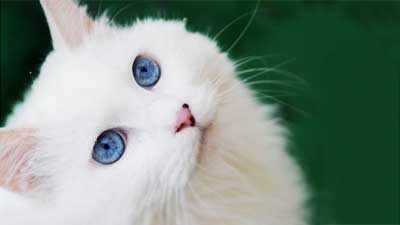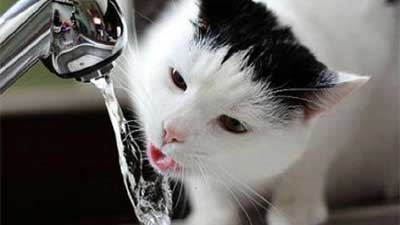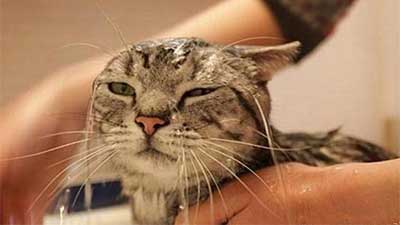What Colors Can A Cat's Eyes Distinguish?

Best Answer:
Cats also have cone cells, so they can also distinguish colors, but cats can only distinguish purple, blue, green, and yellow. For the colors red, orange, and brown, cats see a black to grayscale.
The visual sensory cells of cats are insensitive to most colors and are only sensitive to colors such as gray, blue, and green, so generally only gray, blue, and green appear in the cat's vision.
It can be said that the cat sees all colors with very low saturation. It can clearly see white and gray, and can barely see some blue, green, etc. Most of the colors in the eyes of cats will basically become dark colors of grayscale, that is, gray, so it can be said that cats will relatively prefer gray. Since cats are nocturnal and many mice are gray, cats are more interested in gray.
The colors that humans can distinguish are mainly colors composed of red, green, and blue. Cats see mainly gray, green, and blue tones, and the color saturation is lower than that seen by humans, which means that the colors that cats can see are not very bright colors. Blue and green seem to be the most intense colors a cat can sense.
Do Cats See Colors?
What colors can cat perceive is a common question many cat owners have regarding their feline family. Do cats see humans' exact shades when they glance out the window? Or do they merely have a black-and-white vision?
Although their vision is not as sharp or as far-reaching as human eyesight, it performs better than ours because of their enhanced capacity to see in the dark. Cats see fewer colors than humans do, but they have an incredible capacity for detecting little, quick motions with a considerably wider field of vision.
Additionally, they have a remarkable ability to see in the dark, which makes them superb nocturnal hunters.
The Difference Between Human Vision to Cat Vision
Cats and humans see things differently regarding color perception and other aspects of vision. Cats' vision isn't always as sharp as humans'. Compared to humans, cats have a better close vision. When viewed from the same distance, an object may appear sharp to humans but blurry to our cats.
The retina, a layer of tissue at the back of the eye that contains cells known as photoreceptors, is where the most significant visual differences between humans and cats may be identified. The photoreceptors process light rays into electrical impulses, sorted by nerve cells and transmitted to the brain, where they are interpreted into the images we see. Rods and cones are the names for the two categories of photoreceptor cells. Night vision and peripheral vision are both mediated by rods. They pick up on brightness and grayscale tones. Cones control day vision and color perception. Rod receptors are more abundant, while cone receptors are less abundant in cats. The exact opposite is true of humans, which is why we are better at detecting colors than at night vision.
It has been shown that the colors cats perceive the most clearly are blue colors. More specifically, blue-violet tones are the most easily detected by our cats. However, they can also well see yellow-green light. Cats, unfortunately, cannot see reddish-orange tones. Even if the brilliant red laser pointer is one of your cat's favorite toys, you may be perplexed as to how this is possible. Your cat is not detecting the color directly; instead, it recognizes the light's quick movement.
Cat's Color Vision
Because they have three different types of cones that enable them to see red, green, and blue, humans are classified as trichromats. Although not in a similar way to humans, it is claimed that cats are trichromats as well.
A cat's vision is analogous to that of a color-blind person. Reds and pinks can be puzzling, but they can discern different tints of blue and green. While purple can appear to be a different shade of blue, these could appear greener. Additionally, cats cannot discern colors with the same depth of hue and saturation that we can.
The Bottom Line
Cats are magnificent beings with many peculiarities, and their distinct vision is not a drawback. They merely have accommodations that allow them to survive and function. Cats have a distinct advantage over other animals because they are natural hunters and can detect tiny movements in low light conditions.
You May Also Like
 Breed Reviews10 Cat Breeds with Blue Eyes That Are Beyond Beautiful
Breed Reviews10 Cat Breeds with Blue Eyes That Are Beyond Beautiful Cat HealthWhat Is The Normal Body Temperature Of A Cat?
Cat HealthWhat Is The Normal Body Temperature Of A Cat? Cat HealthDo Cats Carry The Feline Coronavirus For Life?
Cat HealthDo Cats Carry The Feline Coronavirus For Life? Cat BehaviorWhy Don't Cats Like To Drink Water!
Cat BehaviorWhy Don't Cats Like To Drink Water! Help & AdviceHow Many Milliliters Of Water Should A Cat Drink A Day?
Help & AdviceHow Many Milliliters Of Water Should A Cat Drink A Day? Cat BehaviorDo You Know Why Cats Don't Like Water?
Cat BehaviorDo You Know Why Cats Don't Like Water?